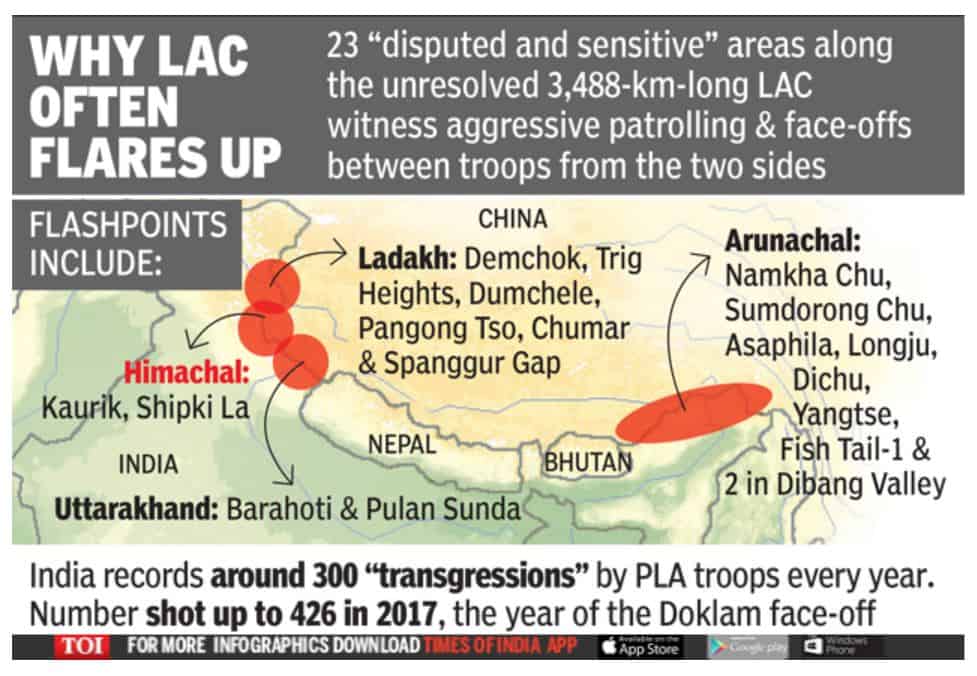UPSC Articles
INTERNATIONAL/ SECURITY
Topic: General Studies 2:
- India and its neighborhood- relations.
The India-China border flare-up
Context: The India-China border has been witnessed tensions during April-May 2020, with incidents reported in at least four different locations along the Line of Actual Control (LAC).

Pic Source: Times of India
Where have the incidents (army clashes) happened?
- The Pangong lake in Ladakh
- Naku La in Sikkim
- Galwan valley and Demchok in Ladakh
Why do face-offs occur?
- Non-Demarcation of LAC: LAC that has never been demarcated. As a result, India and China have overlapping claim lines along LAC which leads to such clashes
- Non-implementation of protocols: Additionally, the Protocols agreed to in 2005 and 2013 regarding rules of engagement to prevent such incidents, have not always been adhered to.
What is behind the latest tensions?
- The northern bank of Pangong lake has always been a point of contention where there are differing perceptions of the LAC.
- The stand-off in Galwan valley(not many incidents in past as LAC was thought to be settled here) was triggered by China moving in troops & equipment to stop construction activity by India
- Delhi says that construction was well within India’s side of the LAC, but China thinks otherwise.
- The broader context for the unexpected tensions in Sikkim appears to be a changing dynamic along the LAC, as India plays catch-up in improving infrastructure there.
- China has enjoyed an advantage in infrastructure as well as terrain that is more favourable to mobilisation in Sikkim area and likes to maintain status-quo.
Why has not the LAC been clarified?
- India has long proposed an exercise to clarify differing perceptions of the LAC to prevent such incidents.
- The exercise could pave the way to regulate activities in contested areas until a final settlement of the boundary dispute.
- Maps were exchanged in the Middle Sector, but the exercise fell through in the Western Sector where divergence is the greatest.
- China has since rejected this exercise, viewing it as adding another complication to the on-going boundary negotiations.
What is the state of boundary negotiations?
- In 2005, an agreement on political parameters and guiding principles completed the first of three stages of the talks.
- The 2005 agreement said both sides “shall safeguard due interests of their settled populations in border areas”.
- The current, and most difficult, stage involves agreeing a framework to resolve the dispute in all sectors.
- The final step will involve delineating and demarcating the boundary in maps and on the ground.
What are the prospects of a settlement?
- The likelihood appears remote.
- The main differences are in the Western and Eastern sectors.
- India sees China as occupying 38,000 sq km in Aksai Chin. In the east, China claims as much as 90,000 sq km, extending all across Arunachal Pradesh.
- One particular sticking point appears to involve China’s claims to Tawang in Arunachal Pradesh, which has been increasingly raised by China in recent years
- A swap was hinted at by China in 1960 and in the early 1980s, which would have essentially formalised the status quo.
- Both sides have now ruled out the status quo as a settlement, agreeing to meaningful and mutual adjustments.
- At the same time, the most realistic solution will involve only minor adjustments along the LAC, considering neither side will be willing to part with territory already held.
What is the Strategic Calculation behind boundary dispute?
- India insists that its relations with China won’t improve fundamentally until the border dispute is resolved
- China appears to view an unsettled border as holding some leverage with India, one of the many pressure points it could use to keep India off-guard
Conclusion
- Until the strategic calculus — and China’s broader view of its relations with India — changes, the stalemate will likely continue
Connecting the dots:
- China’s Belt and Road Initiative & India’s Neighbourhood First Policy
- Panchsheel agreement between India & China in 1954














